Powering Underwater Robotics Sensor Networks Through Ocean Energy Harvesting and Wireless Power Transfer Methods: Systematic Review
Abstract
1. Introduction
1.1. Review and Methodology
- Underwater energy harvesting
- Marine energy sources
- Underwater Wireless Power Transfer
- Underwater sensor networks
- Internet of Underwater Things
- Autonomous underwater vehicle (AUV)
1.2. Article Structure
2. Overview of Underwater Powering Solutions
2.1. Energy Harvesting from Natural Phenomena
2.2. Wireless Power Transfer
2.3. Other Alternatives
2.4. Environmental Considerations
3. Ocean Energy Harvesting
3.1. Waves
3.2. Solar Energy
3.3. Kinetic Energy of Water (Tidal Currents and Flows)
3.4. Temperature Variations
3.5. Fuel Cells
3.6. Piezoelectric Materials
3.7. Summary of Ocean Energy Harvesting Methods
4. Wireless Power Transfer (WPT)
4.1. Inductive Coupling
4.2. Magnetic Resonance
4.3. Ultrasonic/Acoustic Wireless Power Transfer
4.4. Optical Wireless Power Transfer
4.5. Summary of Wireless Power Transmission Methods
5. Discussion and Conclusions
5.1. Challenges in Energy Harvesting (EH) for Underwater Devices
5.2. Challenges in Wireless Power Transfer
5.3. The Trade-Off Between Efficiency and Distance
5.4. Future Research Directions
- Enhancing WPT Efficiency: Research is needed on optimizing beam-forming techniques, reconfigurable intelligent surfaces (RIS) [17,89,90,91], and adaptive transmitter–receiver configurations to improve power transfer efficiency in real-world underwater environments. This also presents an opportunity to examine cost estimates for the different solutions and how cost affects power efficiency.
- Developing Intelligent AUV Control Systems: AUVs must be equipped with smart energy management systems that can monitor the energy status of multiple sensors and prioritize charging based on demand. Algorithms for optimizing charging schedules, minimizing energy loss, and adapting to environmental variations will be crucial for practical deployment.
5.5. Conclusions
Author Contributions
Funding
Data Availability Statement
Conflicts of Interest
Abbreviations
| AC | Alternating Current |
| AUV | Autonomous Underwater Vehicles |
| DC | Direct Current |
| EMI | Electromagnetic Interference |
| EVs | Electric Vehicles |
| IoT | Internet of Things |
| IoUT | Internet of Underwater Things |
| IWPT | Inductive Wireless Power Transfer |
| OEH | Ocean Energy Harvesting |
| OTEC | Ocean Thermal Energy Conversion |
| OWPT | Optical Wireless Power Transfer |
| MFC | Microbial Fuel Cells |
| PMS | Power Management System |
| PV | Photovoltaic |
| PZT | Piezoelectric transducer |
| RF | Radio Frequency |
| RIS | Reconfigurable Intelligent Surface |
| ROV | Remotely operated vehicles |
| UWCN | Underwater Wireless Communication Network |
| UWPT | Underwater Wireless Power Transfer |
| WPT | Wireless Power Transfer |
References
- Dao, N.-N.; Tu, N.H.; Thanh, T.T.; Bao, V.N.Q.; Na, W.; Cho, S. Neglected infrastructures for 6G—Underwater communications: How mature are they? J. Netw. Comput. Appl. 2023, 213, 103595. [Google Scholar] [CrossRef]
- Pompili, D.; Akyildiz, I. Overview of networking protocols for underwater wireless communications. IEEE Commun. Mag. 2009, 47, 97–102. [Google Scholar] [CrossRef]
- Lanbo, L.; Shengli, Z.; Jun-Hong, C. Prospects and problems of wireless communication for underwater sensor networks. Wirel. Commun. Mob. Comput. 2008, 8, 977–994. [Google Scholar] [CrossRef]
- Zhilin, I.V.; Bushnaq, O.M.; Masi, G.D.; Natalizio, E.; Akyildiz, I.F. A Universal Multimode (Acoustic, Magnetic Induction, Optical, RF) Software Defined Modem Architecture for Underwater Communication. IEEE Trans. Wirel. Commun. 2023, 22, 105–116. [Google Scholar] [CrossRef]
- Chen, B.; Hu, J.; Zhao, Y.; Ghosh, B.K. Finite-time observer based tracking control of uncertain heterogeneous underwater vehicles using adaptive sliding mode approach. Neurocomputing 2022, 481, 322–332. [Google Scholar] [CrossRef]
- Ding, F.; Wang, R.; Zhang, T.; Zheng, G.; Wu, Z.; Wang, S. Real-time Trajectory Planning and Tracking Control of Bionic Underwater Robot in Dynamic Environment. Cyborg Bionic Syst. 2024, 5, 0112. [Google Scholar] [CrossRef]
- Bushnaq, O.M.; Zhilin, I.V.; De Masi, G.; Natalizio, E.; Akyildiz, I.F. Automatic Network Slicing for Multi-Mode Internet of Underwater Things (MM-IoUT). In Proceedings of the GLOBECOM 2022-2022 IEEE Global Communications Conference, Rio de Janeiro, Brazil, 4–8 December 2022; pp. 6241–6246. [Google Scholar]
- Xie, L.; Shi, Y.; Hou, Y.T.; Lou, A. Wireless power transfer and applications to sensor networks. IEEE Wirel. Commun. 2013, 20, 140–145. [Google Scholar] [CrossRef]
- Garg, N.; Garg, R. Energy harvesting in IoT devices: A survey. In Proceedings of the 2017 International Conference on Intelligent Sustainable Systems (ICISS), Palladam, India, 7–8 December 2017; pp. 127–131. [Google Scholar]
- Crimmins, D.M.; Patty, C.T.; Beliard, M.A.; Baker, J.; Jalbert, J.C.; Komerska, R.J.; Chappell, S.G.; Blidberg, D.R. Long-Endurance Test Results of the Solar-Powered AUV System. In Proceedings of the OCEANS 2006, Boston, MA, USA, 18–21 September 2006; pp. 1–5. [Google Scholar]
- Teeneti, C.R.; Truscott, T.T.; Beal, D.N.; Pantic, Z. Review of Wireless Charging Systems for Autonomous Underwater Vehicles. IEEE J. Ocean. Eng. 2021, 46, 68–87. [Google Scholar] [CrossRef]
- Martínez de Alegría, I.; Rozas Holgado, I.; Ibarra, E.; Robles, E.; Martín, J.L. Wireless Power Transfer for Unmanned Underwater Vehicles: Technologies, Challenges and Applications. Energies 2024, 17, 2305. [Google Scholar] [CrossRef]
- Stokey, R.; Allen, B.; Austin, T.; Goldsborough, R.; Forrester, N.; Purcell, M.; Alt, C.v. Enabling technologies for REMUS docking: An integral component of an autonomous ocean-sampling network. IEEE J. Ocean. Eng. 2001, 26, 487–497. [Google Scholar] [CrossRef]
- Kesari Mary, D.R.; Ko, E.; Yoon, D.J.; Shin, S.-Y.; Park, S.-H. Energy Optimization Techniques in Underwater Internet of Things: Issues, State-of-the-Art, and Future Directions. Water 2022, 14, 3240. [Google Scholar] [CrossRef]
- Page, M.J.; McKenzie, J.E.; Bossuyt, P.M.; Boutron, I.; Hoffmann, T.C.; Mulrow, C.D.; Shamseer, L.; Tetzlaff, J.M.; Akl, E.A.; Brennan, S.E.; et al. The PRISMA 2020 statement: An updated guideline for reporting systematic reviews. BMJ 2021, 372, n71. [Google Scholar] [CrossRef] [PubMed]
- Islam, K.Y.; Ahmad, I.; Habibi, D.; Waqar, A. A survey on energy efficiency in underwater wireless communications. J. Netw. Comput. Appl. 2022, 198, 103295. [Google Scholar] [CrossRef]
- Wang, H.; Sun, Z.; Guo, H.; Wang, P.; Akyildiz, I.F. Designing Acoustic Reconfigurable Intelligent Surface for Underwater Communications. IEEE Trans. Wirel. Commun. 2023, 22, 8934–8948. [Google Scholar] [CrossRef]
- Wang, D.a.; Zhang, J.; Cui, S.; Bie, Z.; Chen, F.; Zhu, C. The state-of-the-arts of underwater wireless power transfer: A comprehensive review and new perspectives. Renew. Sustain. Energy Rev. 2024, 189, 113910. [Google Scholar] [CrossRef]
- Marra, G.; Fairweather, D.M.; Kamalov, V.; Gaynor, P.; Cantono, M.; Mulholland, S.; Baptie, B.; Castellanos, J.C.; Vagenas, G.; Gaudron, J.-O.; et al. Optical interferometry–based array of seafloor environmental sensors using a transoceanic submarine cable. Science 2022, 376, 874–879. [Google Scholar] [CrossRef]
- Yu, J.; Xu, P.; Yu, Z.; Wen, K.; Yang, J.; Wang, Y.; Qin, Y. Principles and Applications of Seismic Monitoring Based on Submarine Optical Cable. Sensors 2023, 23, 5600. [Google Scholar] [CrossRef]
- Guida, R.; Demirors, E.; Dave, N.; Melodia, T. Underwater Ultrasonic Wireless Power Transfer: A Battery-Less Platform for the Internet of Underwater Things. IEEE Trans. Mob. Comput. 2022, 21, 1861–1873. [Google Scholar] [CrossRef]
- Van Kleunen, W.A.P.; Moseley, N.A.; Havinga, P.J.M.; Meratnia, N. Proteus II: Design and Evaluation of an Integrated Power-Efficient Underwater Sensor Node. Int. J. Distrib. Sens. Netw. 2015, 2015, 1–10. [Google Scholar] [CrossRef]
- Dewan, A.; Ay, S.U.; Karim, M.N.; Beyenal, H. Alternative power sources for remote sensors: A review. J. Power Sources 2014, 245, 129–143. [Google Scholar] [CrossRef]
- Rémouit, F.; Ruiz-Minguela, P.; Engström, J. Review of Electrical Connectors for Underwater Applications. IEEE J. Ocean. Eng. 2018, 43, 1037–1047. [Google Scholar] [CrossRef]
- Alam, T.R.; Tchouaso, M.T.; Prelas, M.A. Summary of the design principles of betavoltaics and space applications. In Photovoltaics for Space; Elsevier: Amsterdam, The Netherlands, 2023; pp. 293–345. [Google Scholar]
- Altana, C.; Cottone, F.; Mengoni, D. First Simulations on Higher-Efficiency Betavoltaic Battery Integrated with Electrets for Space, Medicine and Remote Sensing Applications. In Proceedings of the 2022 21st International Conference on Micro and Nanotechnology for Power Generation and Energy Conversion Applications (PowerMEMS), Salt Lake City, UT, USA, 12–15 December 2022; pp. 245–247. [Google Scholar]
- Cuthbertson, A. Nuclear Battery Produces Power for 50 Years Without Needing to Charge. Independent UK Edition. 1 February 2024. Available online: https://www.independent.co.uk/tech/nuclear-battery-betavolt-atomic-china-b2476979.html (accessed on 2 November 2024).
- Xu, F.; Huang, H. Frequency selection for underwater wireless power transfer based on the analysis of eddy current loss. AEU-Int. J. Electron. Commun. 2023, 163, 154618. [Google Scholar] [CrossRef]
- Bang, K.; Park, S. Design and Characteristics of Underwater Stacked Capacitive Power Transfer Coupler and Analysis of Propagation in Water Medium. Appl. Sci. 2025, 15, 1901. [Google Scholar] [CrossRef]
- Webb, P. Introduction to Oceanography; Rebus Community: Montreal, QC, Canada, 2019. [Google Scholar]
- Mohsan, S.A.H.; Khan, M.A.; Mazinani, A.; Alsharif, M.H.; Cho, H.-S. Enabling Underwater Wireless Power Transfer towards Sixth Generation (6G) Wireless Networks: Opportunities, Recent Advances, and Technical Challenges. J. Mar. Sci. Eng. 2022, 10, 1282. [Google Scholar] [CrossRef]
- Lampitt, R.S. Marine Snow. In Encyclopedia of Ocean Sciences; Steele, J.H., Ed.; Academic Press: Oxford, UK, 2001; pp. 1667–1675. [Google Scholar]
- Detlefsen, C. About the Marianas/Geological Survey of Denmark and Greenland. Ingeniøren, 2 November 2013. [Google Scholar]
- Khan, M.Z.A.; Khan, H.A.; Aziz, M. Harvesting Energy from Ocean: Technologies and Perspectives. Energies 2022, 15, 3456. [Google Scholar] [CrossRef]
- Koca, K.; Kortenhaus, A.; Oumeraci, H.; Zanuttigh, B.; Angelelli, E.; Cantu, M.; Suffredini, R.; Franceschi, G. Recent advances in the development of wave energy converters. In Proceedings of the 9th European Wave and Tidal Energy Conference (EWTEC), Southampton, UK, 5–9 September 2011; pp. 2–5. [Google Scholar]
- Lu, Z.; Shang, J.; Luo, Z.; Zhu, Y.; Wang, M.; Wang, C. Research on environmental energy-driven intelligent unmanned underwater vehicles and their key technologies. In Proceedings of the 2021 IEEE 4th International Conference on Automation, Electronics and Electrical Engineering (AUTEEE), Shenyang, China, 19–21 November 2021; pp. 564–571. [Google Scholar]
- Jalbert, J.; Baker, J.; Duchesney, J.; Pietryka, P.; Dalton, W.; Blidberg, D.R.; Chappell, S.; Nitzel, R.; Holappa, K. A solar-powered autonomous underwater vehicle. In Proceedings of the Oceans 2003. Celebrating the Past… Teaming Toward the Future (IEEE Cat. No.03CH37492), San Diego, CA, USA, 22–26 September 2003; Volume 1132, pp. 1132–1140. [Google Scholar]
- Röhr, J.A.; Lipton, J.; Kong, J.; Maclean, S.A.; Taylor, A.D. Efficiency Limits of Underwater Solar Cells. Joule 2020, 4, 840–849. [Google Scholar] [CrossRef]
- Fukutani, K.; Kanbe, M.; Futako, W.; Kaplan, B.; Kamiya, T.; Fortmann, C.M.; Shimizu, I. Band gap tuning of a-Si:H from 1.55 eV to 2.10 eV by intentionally promoting structural relaxation. J. Non-Cryst. Solids 1998, 227–230, 63–67. [Google Scholar] [CrossRef]
- Baumeister, P.W. Optical absorption of cuprous oxide. Phys. Rev. 1961, 121, 359. [Google Scholar] [CrossRef]
- Chu, T.; Chu, S.; Ferekides, C.; Britt, J. Films and junctions of cadmium zinc telluride. J. Appl. Phys. 1992, 71, 5635–5640. [Google Scholar] [CrossRef]
- Sarswat, P.K.; Free, M.L. Enhanced photoelectrochemical response from copper antimony zinc sulfide thin films on transparent conducting electrode. Int. J. Photoenergy 2013, 2013, 154694. [Google Scholar] [CrossRef]
- El Allali, M.; So, C.; Veje, E.; Tidemand-Petersson, P. Experimental determination of the GaAs and Ga1−xAlxAs band-gap energy dependence on temperature and aluminum mole fraction in the direct band-gap region. Phys. Rev. B 1993, 48, 4398. [Google Scholar] [CrossRef]
- Tomasulo, S.; Nay Yaung, K.; Faucher, J.; Vaisman, M.; Lee, M. Metamorphic 2.1–2.2 eV InGaP solar cells on GaP substrates. Appl. Phys. Lett. 2014, 104, 173903. [Google Scholar] [CrossRef]
- Grassman, T.J.; Carlin, A.M.; Grandal, J.; Ratcliff, C.; Yang, L.; Mills, M.J.; Ringel, S.A. Spectrum-optimized Si-based III-V multijunction photovoltaics. In Proceedings of the Physics, Simulation, and Photonic Engineering of Photovoltaic Devices, San Francisco, CA, USA, 21–26 February 2012; pp. 130–135. [Google Scholar]
- Kamal, S.; Al-sayyad, G.M.; Abdelmoteleb, R.; Abdellatif, M.; Abdellatif, S.O. Submerged Solar Energy Harvesters Performance for Underwater Applications. In Proceedings of the 2019 International Conference on Innovative Trends in Computer Engineering (ITCE), Aswan, Egypt, 2–4 February 2019; pp. 444–449. [Google Scholar]
- Rosli, R.; Dimla, E. A review of tidal current energy resource assessment: Current status and trend. In Proceedings of the 2018 5th International Conference on Renewable Energy: Generation and Applications (ICREGA), Al Ain, United Arab Emirates, 25–28 February 2018; pp. 34–40. [Google Scholar]
- Kadiri, M.; Ahmadian, R.; Bockelmann-Evans, B.; Falconer, R.A.; Kay, D. An assessment of the impacts of a tidal renewable energy scheme on the eutrophication potential of the Severn Estuary, UK. Comput. Geosci. 2014, 71, 3–10. [Google Scholar] [CrossRef]
- Alvarez, E.A.; Rico-Secades, M.; Suárez, D.F.; Gutiérrez-Trashorras, A.J.; Fernández-Francos, J. Obtaining energy from tidal microturbines: A practical example in the Nalón River. Appl. Energy 2016, 183, 100–112. [Google Scholar] [CrossRef]
- Khan, A.; Imran, M.; Alharbi, A.; Mohamed, E.M.; Fouda, M.M. Energy Harvesting in Underwater Acoustic Wireless Sensor Networks: Design, Taxonomy, Applications, Challenges and Future Directions. IEEE Access 2022, 10, 134606–134622. [Google Scholar] [CrossRef]
- Chao, Y. Autonomous underwater vehicles and sensors powered by ocean thermal energy. In Proceedings of the OCEANS 2016-Shanghai, Shanghai, China, 10–13 April 2016; pp. 1–4. [Google Scholar]
- Haldeman, C.D.; Schofield, O.; Webb, D.C.; Valdez, T.I.; Jones, J.A. Implementation of energy harvesting system for powering thermal gliders for long duration ocean research. In Proceedings of the OCEANS 2015-MTS/IEEE Washington, Washington, DC, USA, 19–22 October 2015; pp. 1–5. [Google Scholar]
- Domingo, M.C. An overview of the internet of underwater things. J. Netw. Comput. Appl. 2012, 35, 1879–1890. [Google Scholar] [CrossRef]
- Rabaey, K.; Verstraete, W. Microbial fuel cells: Novel biotechnology for energy generation. Trends Biotechnol. 2005, 23, 291–298. [Google Scholar] [CrossRef]
- Dai, J.; Li, X.; Li, B.; Wang, L. Design and modeling of an underwater energy harvesting system. In Proceedings of the International Symposium on Circuits and Systems (ISCAS), Rio de Janeiro, Brazil, 15–18 May 2011. [Google Scholar]
- Donovan, C.; Dewan, A.; Peng, H.; Heo, D.; Beyenal, H. Power management system for a 2.5W remote sensor powered by a sediment microbial fuel cell. J. Power Sources 2011, 196, 1171–1177. [Google Scholar] [CrossRef]
- Li, Z.; Roscow, J.; Khanbareh, H.; Haswell, G.; Bowen, C. Energy Harvesting from Water Flow by Using Piezoelectric Materials. Adv. Energy Sustain. Res. 2024, 5, 2300235. [Google Scholar] [CrossRef]
- Hui, S.Y.R.; Ho, W.W.C. A new generation of universal contactless Battery Charging platform for portable Consumer Electronic equipment. IEEE Trans. Power Electron. 2005, 20, 620–627. [Google Scholar] [CrossRef]
- Ko, Y.D.; Jang, Y.J. The Optimal System Design of the Online Electric Vehicle Utilizing Wireless Power Transmission Technology. IEEE Trans. Intell. Transp. Syst. 2013, 14, 1255–1265. [Google Scholar] [CrossRef]
- Li, Z.-S.; Li, D.-J.; Lin, L.; Chen, Y. Design considerations for electromagnetic couplers in contactless power transmission systems for deep-sea applications. J. Zhejiang Univ. Sci. C 2010, 11, 824–834. [Google Scholar] [CrossRef]
- Feezor, M.D.; Sorrell, F.Y.; Blankinship, P.R. An interface system for autonomous undersea vehicles. IEEE J. Ocean. Eng. 2001, 26, 522–525. [Google Scholar] [CrossRef]
- McGinnis, T.; Henze, C.P.; Conroy, K. Inductive Power System for Autonomous Underwater Vehicles. In Proceedings of the OCEANS 2007, Vancouver, BC, Canada, 29 September–4 October 2007; pp. 1–5. [Google Scholar]
- Wang, S.-l.; Song, B.-w.; Duan, G.-l.; Du, X.-z. Automatic wireless power supply system to autonomous underwater vehicles by means of electromagnetic coupler. J. Shanghai Jiaotong Univ. (Sci.) 2014, 19, 110–114. [Google Scholar] [CrossRef]
- Anyapo, C.; Intani, P. Wireless Power Transfer for Autonomous Underwater Vehicle. In Proceedings of the 2020 IEEE PELS Workshop on Emerging Technologies: Wireless Power Transfer (WoW), Seoul, Republic of Korea, 15–19 November 2020; pp. 246–249. [Google Scholar]
- Pessoa, L.M.; Pereira, M.R.; Santos, H.M.; Salgado, H.M. Simulation and experimental evaluation of a resonant magnetic wireless power transfer system for seawater operation. In Proceedings of the OCEANS 2016-Shanghai, Shanghai, China, 10–13 April 2016; pp. 1–5. [Google Scholar]
- Yang, L.; Li, X.; Zhang, Y.; Feng, B.; Yang, T.; Wen, H.; Tian, J.; Zhu, D.; Huang, J.; Zhang, A.; et al. A review of underwater inductive wireless power transfer system. IET Power Electron. 2024, 17, 894–905. [Google Scholar] [CrossRef]
- Kan, T.; Mai, R.; Mercier, P.P.; Mi, C.C. Design and Analysis of a Three-Phase Wireless Charging System for Lightweight Autonomous Underwater Vehicles. IEEE Trans. Power Electron. 2018, 33, 6622–6632. [Google Scholar] [CrossRef]
- Shi, J.-G.; Li, D.-J.; Yang, C.-J. Design and analysis of an underwater inductive coupling power transfer system for autonomous underwater vehicle docking applications. J. Zhejiang Univ. Sci. C 2014, 15, 51–62. [Google Scholar] [CrossRef]
- Shizuno, K.; Yoshida, S.; Tanomura, M.; Hama, Y. Long distance high efficient underwater wireless charging system using dielectric-assist antenna. In Proceedings of the 2014 Oceans-St. John’s, St. John’s, NL, Canada, 14–19 September 2014; pp. 1–3. [Google Scholar]
- Yoshida, S.; Tanomura, M.; Hama, Y.; Hirose, T.; Suzuki, A.; Matsui, Y.; Sogo, N.; Sato, R. Underwater wireless power transfer for non-fixed unmanned underwater vehicle in the ocean. In Proceedings of the 2016 IEEE/OES Autonomous Underwater Vehicles (AUV), Tokyo, Japan, 6–9 November 2016; pp. 177–180. [Google Scholar]
- Hui, S.Y.R.; Zhong, W.; Lee, C.K. A Critical Review of Recent Progress in Mid-Range Wireless Power Transfer. IEEE Trans. Power Electron. 2014, 29, 4500–4511. [Google Scholar] [CrossRef]
- Kurs, A.; Karalis, A.; Moffatt, R.; Joannopoulos, J.D.; Fisher, P.; Soljačić, M. Wireless Power Transfer via Strongly Coupled Magnetic Resonances. Science 2007, 317, 83–86. [Google Scholar] [CrossRef]
- Mohsan, S.A.H.; Islam, A.; Ali, M.; Mahmood, A.; Selsabil, L.; Mazinani, A.; Amjad, H. A Review on Research Challenges, Limitations and Practical Solutions for Underwater Wireless Power Transfer. Int. J. Adv. Comput. Sci. Appl. 2020, 11, 554–562. [Google Scholar] [CrossRef]
- Yu, L.; Sun, H.; Su, S.; Tang, H.; Sun, H.; Zhang, X. Review of Crucial Problems of Underwater Wireless Power Transmission. Electronics 2023, 12, 163. [Google Scholar] [CrossRef]
- Jadidian, J.; Katabi, D. Magnetic MIMO: How to charge your phone in your pocket. In Proceedings of the MobiCom’14: The 20th Annual International Conference on Mobile Computing and Networking, Maui, HI, USA, 7–11 September 2014; pp. 495–506. [Google Scholar]
- Wibisono, A.; Alsharif, M.H.; Song, H.-K.; Lee, B.M. A Survey on Underwater Wireless Power and Data Transfer System. IEEE Access 2024, 12, 34942–34957. [Google Scholar] [CrossRef]
- Afzal, S.S.; Akbar, W.; Rodriguez, O.; Doumet, M.; Ha, U.; Ghaffarivardavagh, R.; Adib, F. Battery-free wireless imaging of underwater environments. Nat. Commun. 2022, 13, 5546. [Google Scholar] [CrossRef] [PubMed]
- Akafua, J.; Chapman, R.; Guo, H. A Design of Wireless Communication and Wireless Energy Transfer System for In-Pipe Robots. In Proceedings of the 2021 IEEE International Conference on Wireless for Space and Extreme Environments (WiSEE), Cleveland, OH, USA, 12–14 October 2021; pp. 84–89. [Google Scholar]
- Zhao, Y.; Du, Y.; Wang, Z.; Wang, J.; Geng, Y. Design of Ultrasonic Transducer Structure for Underwater Wireless Power Transfer System. In Proceedings of the 2021 IEEE Wireless Power Transfer Conference (WPTC), San Diego, CA, USA, 1–4 June 2021; pp. 1–4. [Google Scholar]
- Chen, X.; Xu, K.; Mu, X.; Li, G. Comparisons of inductive coupling and ultrasonic coupling wireless power transfer under seawater. Dianji Yu Kongzhi Xuebao/Electr. Mach. Control 2018, 22, 9–16. [Google Scholar]
- Pinuela, M.; Yates, D.C.; Lucyszyn, S.; Mitcheson, P.D. Maximizing DC-to-Load Efficiency for Inductive Power Transfer. IEEE Trans. Power Electron. 2013, 28, 2437–2447. [Google Scholar] [CrossRef]
- Kim, S.-M.; Kwon, D. Transfer Efficiency of Underwater Optical Wireless Power Transmission Depending on the Operating Wavelength. Curr. Opt. Photon. 2020, 4, 571–575. [Google Scholar] [CrossRef]
- Lyu, W.; Li, X.; Zhang, Y.; Guan, X.; Zhang, Z.; Xu, J. Experimental demonstration of underwater wireless optical OFDM communication system with a single SPAD receiver. Opt. Commun. 2022, 508, 127767. [Google Scholar] [CrossRef]
- Liu, Q.; Wu, J.; Xia, P.; Zhao, S.; Chen, W.; Yang, Y.; Hanzo, L. Charging Unplugged: Will Distributed Laser Charging for Mobile Wireless Power Transfer Work? IEEE Veh. Technol. Mag. 2016, 11, 36–45. [Google Scholar] [CrossRef]
- Hajimiri, A.; Abiri, B.; Bohn, F.; Gal-Katziri, M.; Manohara, M.H. Dynamic Focusing of Large Arrays for Wireless Power Transfer and Beyond. IEEE J. Solid-State Circuits 2021, 56, 2077–2101. [Google Scholar] [CrossRef]
- Wu, T.-C.; Chi, Y.-C.; Wang, H.-Y.; Tsai, C.-T.; Lin, G.-R. Blue Laser Diode Enables Underwater Communication at 12.4 Gbps. Sci. Rep. 2017, 7, 40480. [Google Scholar] [CrossRef]
- Zhang, B.; Xu, W.; Lu, C.; Lu, Y.; Wang, X. Review of low-loss wireless power transfer methods for autonomous underwater vehicles. IET Power Electron. 2022, 15, 775–788. [Google Scholar] [CrossRef]
- Karalis, A.; Joannopoulos, J.D.; Soljačić, M. Efficient wireless non-radiative mid-range energy transfer. Ann. Phys. 2008, 323, 34–48. [Google Scholar] [CrossRef]
- Kisseleff, S.; Akyildiz, I.F.; Gerstacker, W.H. Magnetic Induction-Based Simultaneous Wireless Information and Power Transfer for Single Information and Multiple Power Receivers. IEEE Trans. Commun. 2017, 65, 1396–1410. [Google Scholar] [CrossRef]
- Sun, Z.; Guo, H.; Akyildiz, I.F. High-Data-Rate Long-Range Underwater Communications via Acoustic Reconfigurable Intelligent Surfaces. IEEE Commun. Mag. 2022, 60, 96–102. [Google Scholar] [CrossRef]
- Yang, G.; Moghadam, M.R.V.; Zhang, R. Magnetic MIMO Signal Processing and Optimization for Wireless Power Transfer. IEEE Trans. Signal Process. 2017, 65, 2860–2874. [Google Scholar] [CrossRef]

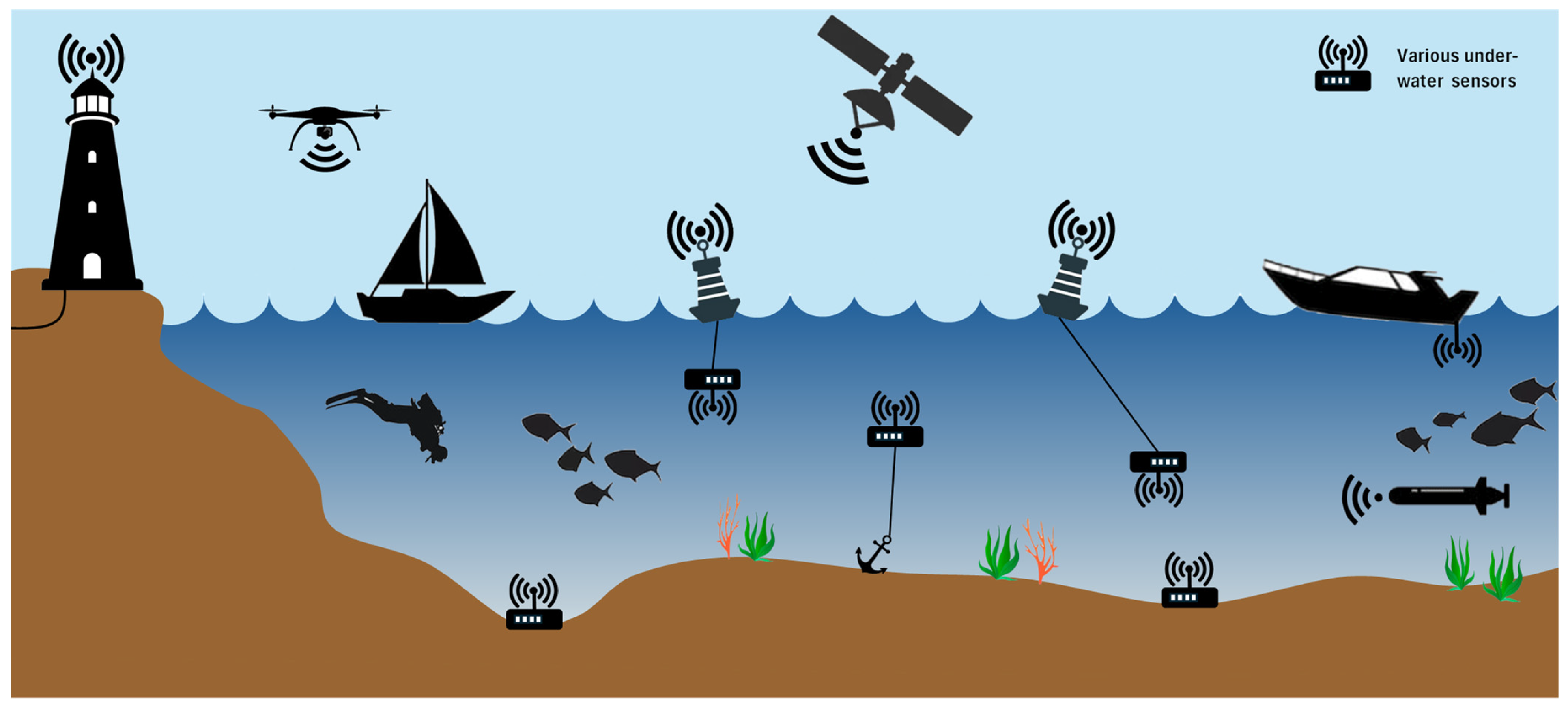

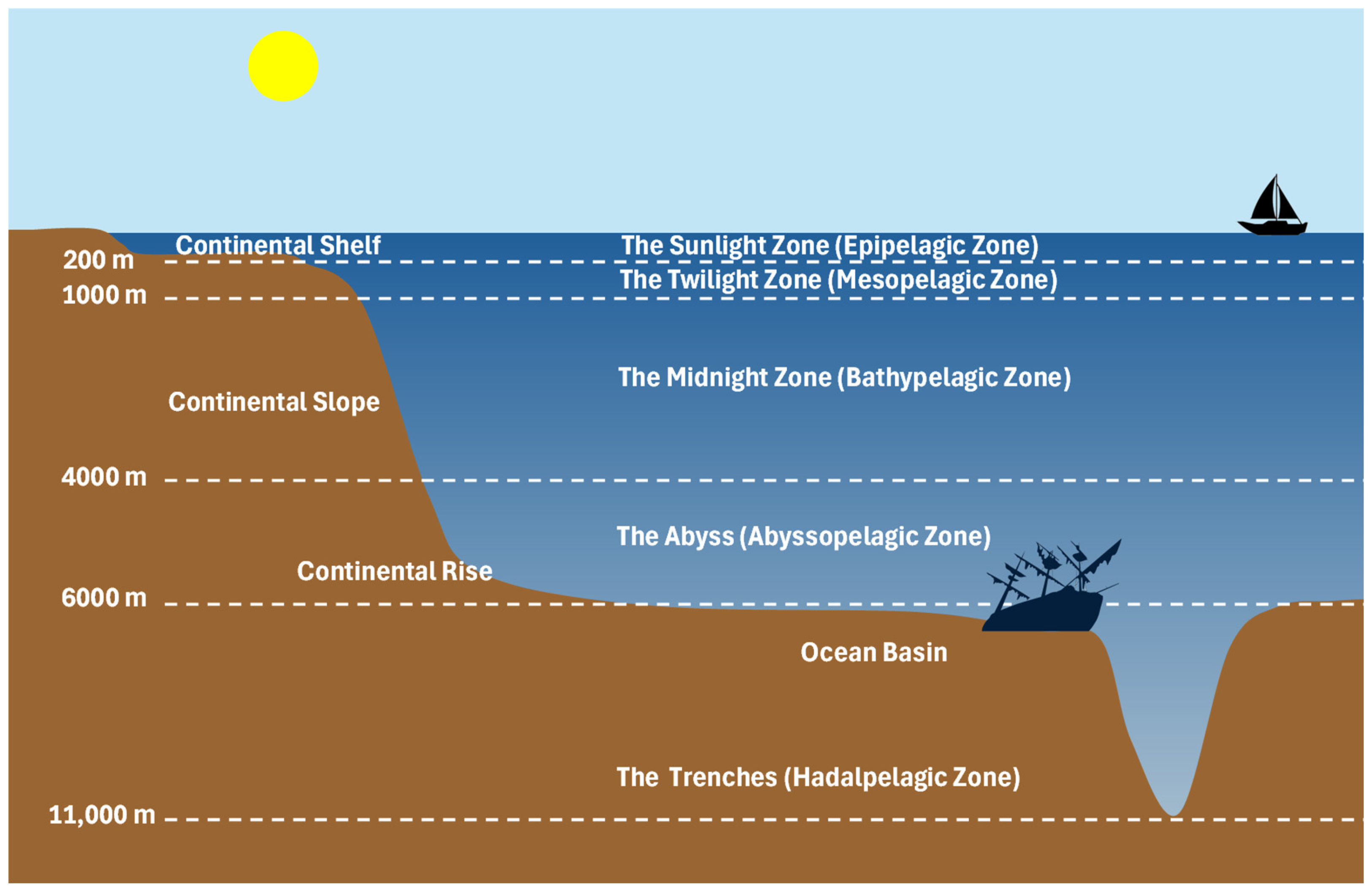

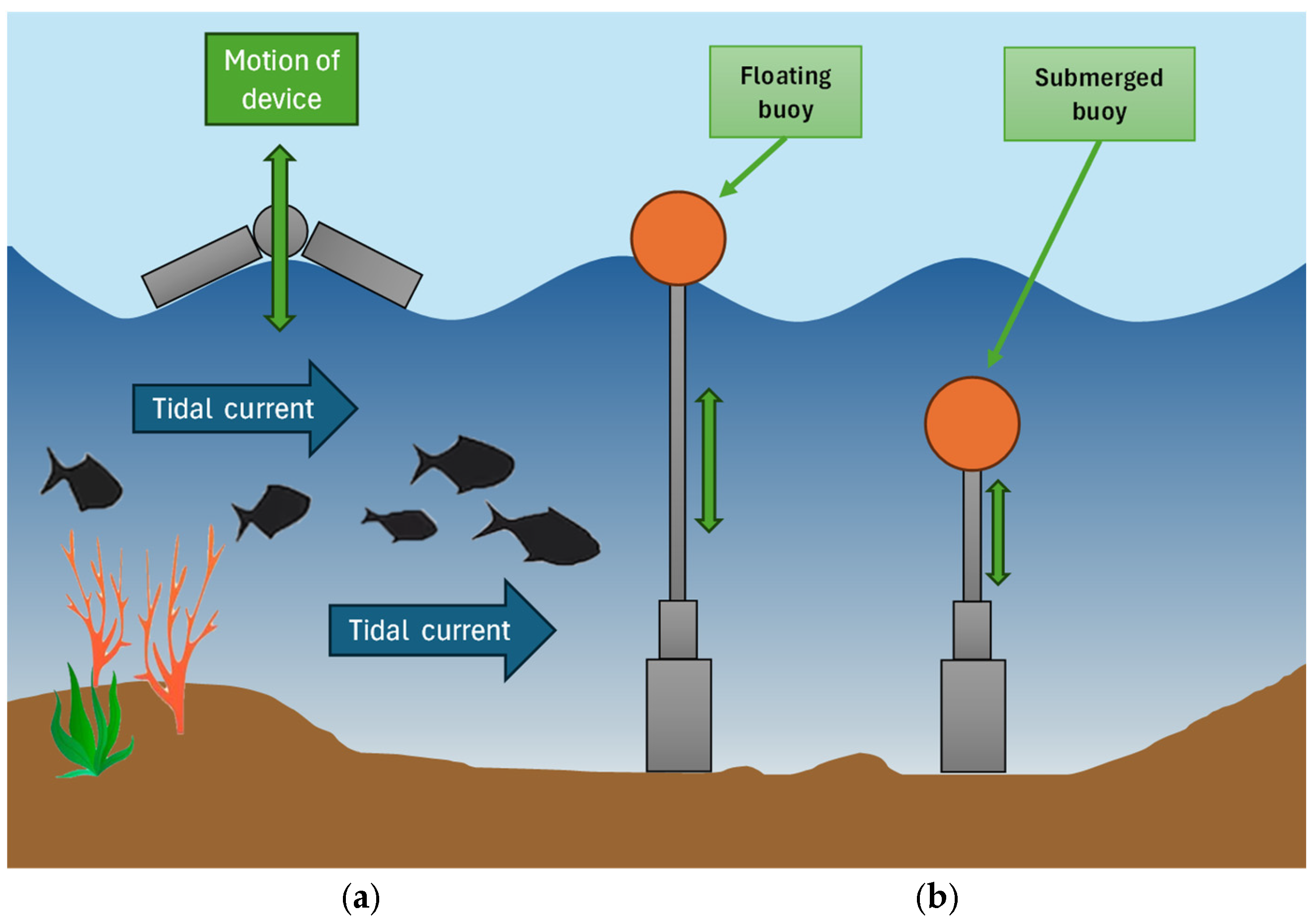
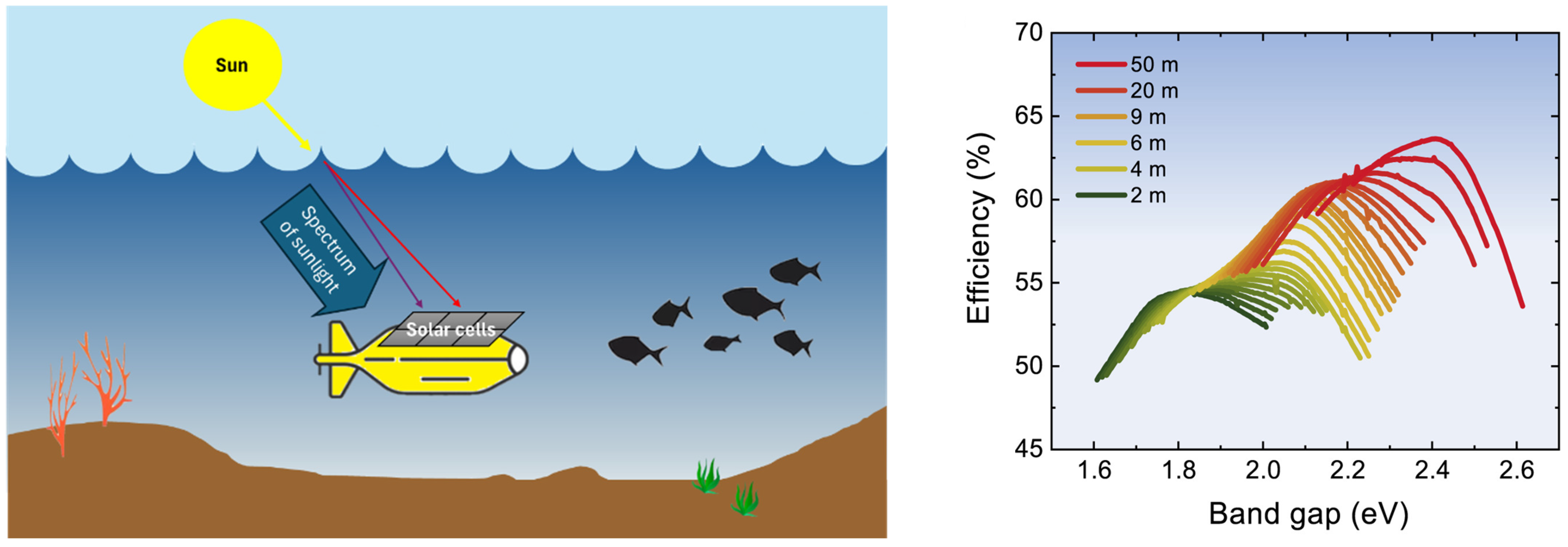


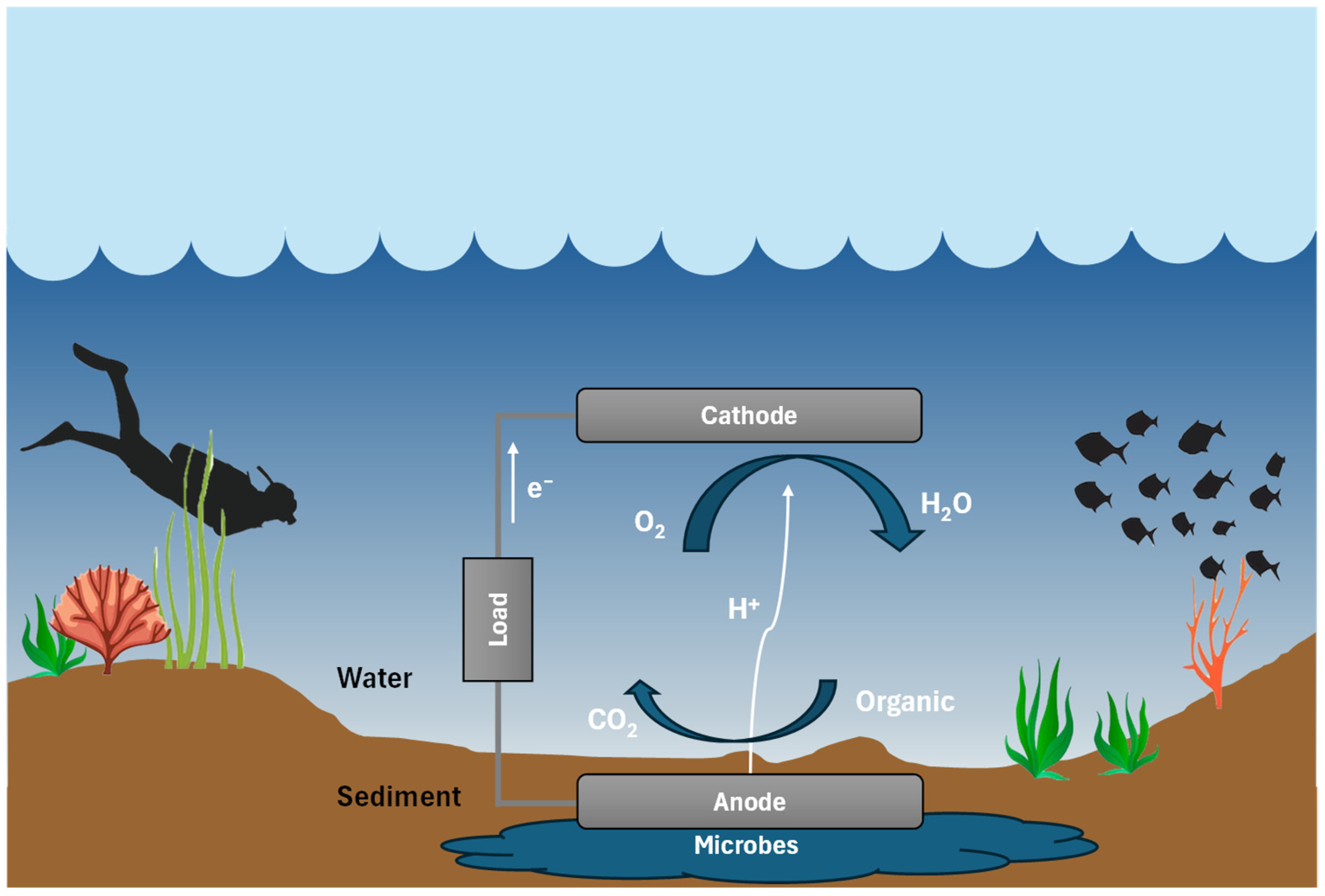
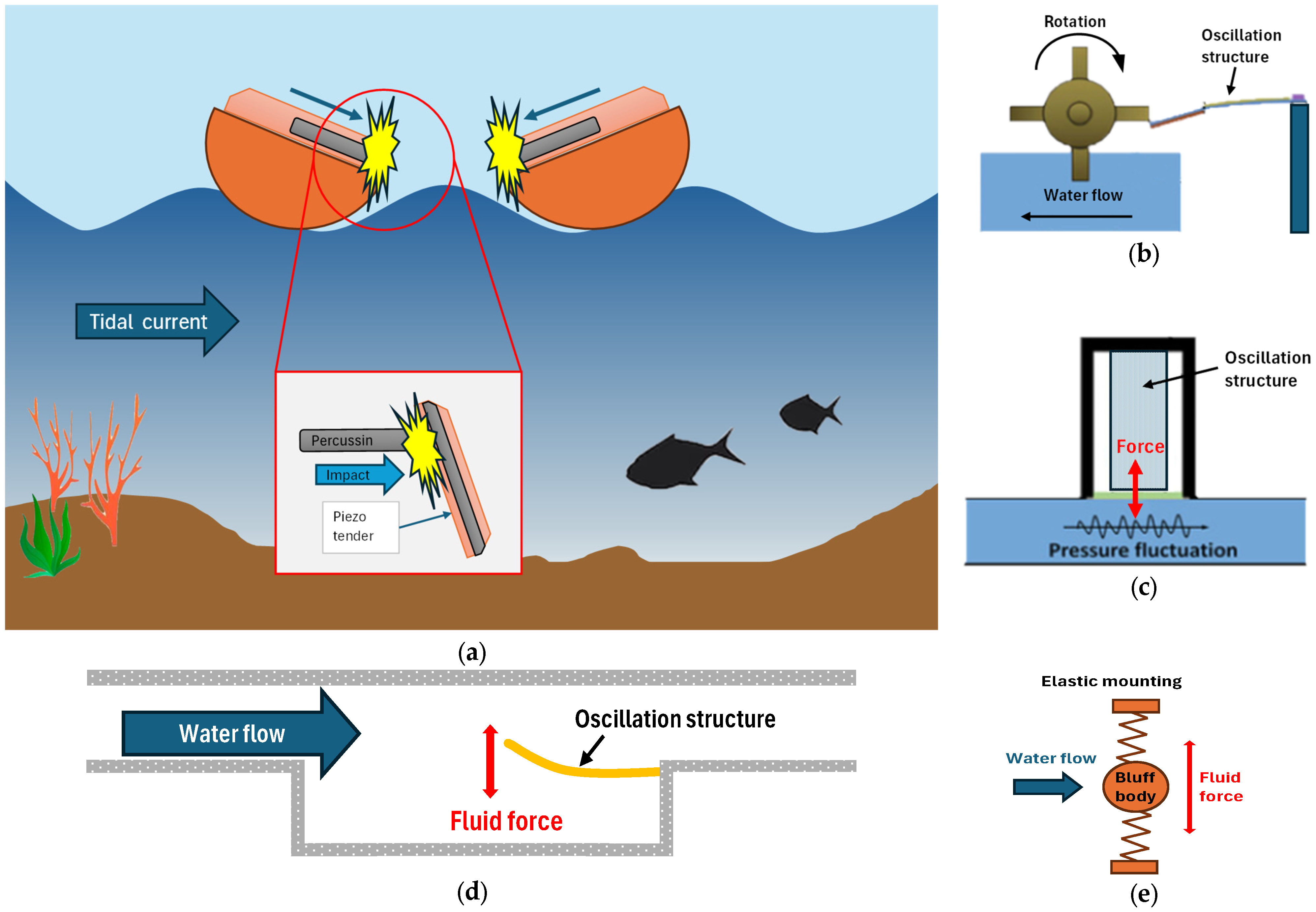

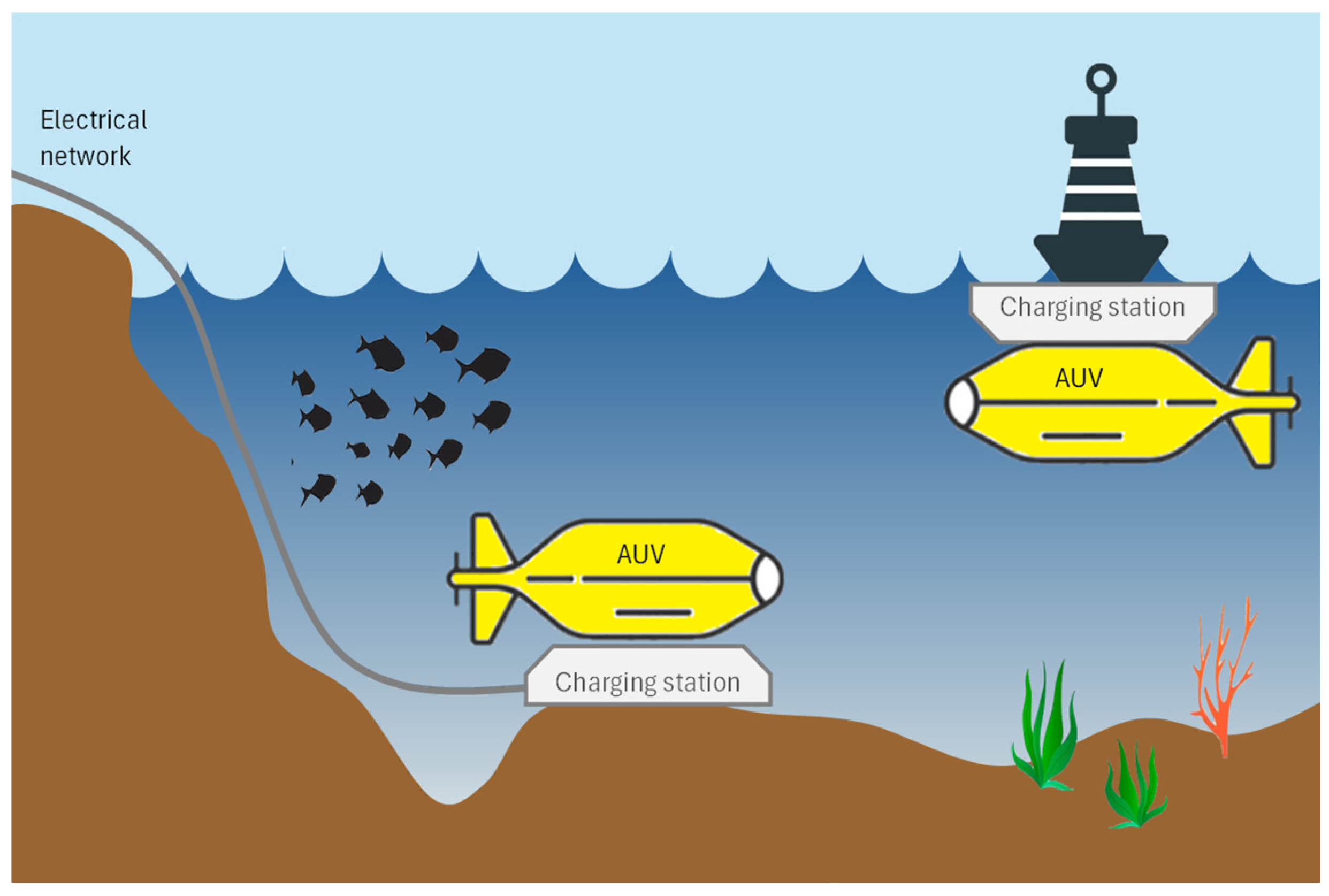



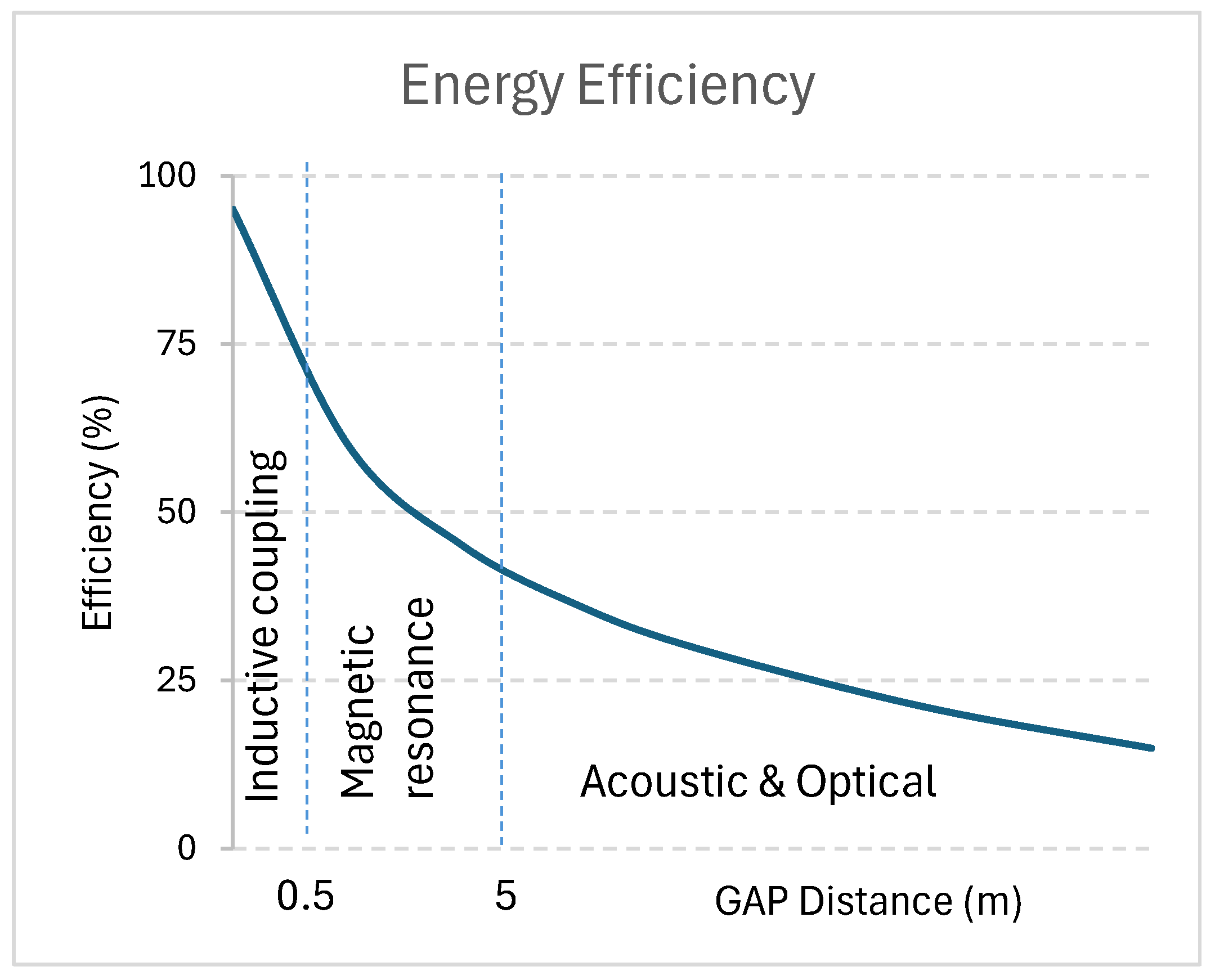
| Environmental Factor | Effects on Technical Devices |
|---|---|
| Sunlight | Natural sunlight does not penetrate deep into the ocean. The first 200 m, known as the sunlight zone, provides some opportunities for utilizing solar energy. For instance, plants convert sunlight into food through photosynthesis [32]. Research has explored various solar energy options available beneath the water’s surface. |
| Temperature | Ocean temperatures range from approximately −2 °C to 30 °C. The warmest waters are typically found at the surface in tropical regions, while surface waters near the poles are much colder. Despite the warmth of surface waters, most ocean water is deeper and frigid, resulting in an average temperature of about 4 °C. The temperature remains relatively constant in the upper 100–200 m, called the mixed layer. Below this layer is a sharp temperature drop over a relatively small depth increase known as the thermocline. Beyond the thermocline, the temperature in the deep ocean stabilizes around 2 °C, extending to the ocean floor, making it one of Earth’s most thermally stable regions [30] |
| Pressure | The pressure in the ocean increases by approximately 1 atmosphere for every 10 m of depth. Consequently, the ocean depths are subject to extreme pressures, often ranging from 40 to over 100 times the pressure of Earth’s atmosphere [3,30]. |
| Salinity | Salinity remains remarkably constant throughout the deep sea, averaging about 35 parts per thousand. While there are minor variations in salinity, they are generally insignificant, except in large landlocked seas such as the Mediterranean and the Red Sea [33]. |
| Water Current | Water currents can serve as a potential energy source; however, they also pose challenges as they can affect the usability and performance of technical devices. Ocean currents may displace devices within the sea, leading to destabilization, such as the misalignment of transmitter and receiver coils used for WPT [21]. |
| Biofouling | Microorganisms thrive in aquatic environments, and their growth on devices can result in misalignment and increased gaps between components. Literature suggests that heating can reduce biofouling, and specialized antifouling coatings may also be effective [31]. |
| Ocean Energy Harvesting Techniques | ||
|---|---|---|
| Technique | Pros | Cons |
| Waves | Provides a continuous and predictable energy source, as wave patterns can be forecasted. High energy density. | Installation and maintenance can be challenging due to harsh environmental conditions. Requires extensive knowledge of ocean dynamics. |
| Solar Energy | High availability, particularly in areas with consistent sunlight (e.g., tropics). Scalable with low environmental impact. | Limited efficiency due to reduced sunlight reaching floating cells. Deep waters make this option less viable. |
| Kinetic Energy of Water | Offers a predictable and consistent energy source, especially from tidal flows. High energy density, as ocean currents and tides carry significant kinetic energy. | Primarily applicable in specific geographic regions with strong currents or tidal flows. Maintenance can be complex and costly. Potential disruption to marine life and navigation. |
| Temperature Variations | A proven and reliable energy source in tropical regions where temperature gradients are consistent. | Applicable in regions with significant temperature gradients between the surface and deep waters. It may pose risks to marine ecosystems due to the disruption of the mixing of water layers. |
| Fuel Cells | Low environmental impact, as they rely on organic materials and microbes. It can serve as a power source for underwater sensors and autonomous systems with minimal energy needs. | Limited power output; more suitable for small, low-power applications. Efficiency depends on local sediment composition and microbial activity. Susceptible to biofouling, which reduces efficiency over time. |
| Piezoelectric Material | Converts mechanical stress from waves or currents into electricity. Minimal environmental impact when placed strategically. Can autonomously power small, low-energy devices. | Currently, low power output makes it inefficient for large-scale energy needs. Durability concerns, as piezoelectric materials may degrade in harsh marine conditions. Costly and limited to specific applications rather than broad-scale energy production. |
| Technique | Reference | Main Contribution | Limitations |
|---|---|---|---|
| Waves | M.Z.A. Khan (2022) [34] | Overview of wave energy technologies in the broader ocean energy context. | Not only wave energy nor a comparison of the methods. Has limited technical depth in the conclusion. |
| K. Koca (2013) [35] | Focused review of wave energy converters (WECs). | Good overview for its time, but it was published more than 10 years ago. | |
| Z. Lu (2021) [36] | Discusses key technologies possible for UUVs to be powered by environmental energy sources. | Lack of specificity on wave energy harvesting and absence of experimental validation. | |
| Solar Energy | Lu [36] (2021) | Environmental energy use in UUVs, including solar. | Focused on vehicle systems, not solar tech itself or validation of solar harvesting underwater. |
| J. Jalbert [37] (2003) | An early prototype of a solar-powered AUV was tested in shallow waters. | Limited operational depth and published more than 20 years ago make it limited as a state-of-the-art solution. | |
| Fukutani [39] (1998) | Tuning the a-Si:H band gap for solar cell optimization. | Material-level research; no testing in water/ocean environments or device applications. | |
| Sarswat & Free [42] (2013) | Enhanced photoelectrochemical response for solar applications, with potential underwater relevance. | No specific underwater validation; tested only in controlled (dry) lab conditions. | |
| Tomasulo [44] (2014) | Designed high-bandgap solar cells suitable for shallow water. | Device performance not tested in marine or submerged environments. | |
| Kinetic Energy of Water | R. Rosli & E. Dimla [47] (2018) | Reviews the methodologies for assessing tidal current energy resources | Concentrates on resource assessment rather than device technology or efficiency |
| M. Kadiri [48] (2014) | Investigates the environmental impacts of tidal energy schemes. | May not generalize to other locations or device types; mainly evaluates environmental impact, not energy extraction performance. | |
| Alvarez [49] (2016) | Presents a practical implementation of tidal microturbines for energy harvesting, providing real-world performance data. | Small-scale and very localized, it lacks generalizability and upscaling possibilities. | |
| Temperature Variations | Y. Chao [51] (2016) | Describes the use of ocean thermal energy to power AUVs and sensors. | No performance results provided and scalability not fully addressed. |
| Haldeman [52] (2015) | Demonstrates thermal-powered gliders for long-duration missions. | Field deployment demonstrated, but optimization for varying ocean conditions is still needed | |
| Domingo [53] (2012) | Explores thermal strategies for IoUT. | High-level review; no experimental data, and an over 10-year-old publication. | |
| Fuel Cells | Guida [21] (2022) | Develops an underwater ultrasonic WPT system; briefly mentions MFCs as a complementary technology. | The main focus is wireless acoustics; MFCs are discussed only superficially. |
| Domingo [53] (2012) | High-level overview of IoUT, suggesting MFCs as an energy harvesting method. | Lacks technical analysis, experimental data, or performance evaluations. | |
| Rabaey and Verstraete [54] (2005) | Detailed review of MFCs, including mechanisms, potential, and applications in biotechnology. | Focus on terrestrial and wastewater contexts; marine-specific challenges are not addressed. | |
| Dai [55] (2011) | Proposed design and modeling of underwater energy systems, including using MFCs for underwater harvesting. | No experimental validation or field testing; model-driven study. | |
| Donovan [56] (2011) | Designs a PMS for sensors powered by a sediment MFC, for practical small-scale deployment. | Limited to low-power (2.5 W) systems; scalability and harsh marine deployment not fully explored. | |
| A. Khan [50] (2022) | MFCs as energy solutions for remote underwater networks. | Early-stage, low power outputs | |
| Piezoelectric Materials | M.Z.A. Khan [34] (2022) | Discusses piezoelectric energy harvesting as one of the ocean energy technologies | Comprehensive overview; no technical depth |
| A. Dewan [23] (2014) | Reviews power sources for remote sensors; includes piezoelectric materials for EH in aquatic environments. | General review: limited experimental insights into marine-specific implementations | |
| Z. Li [57] (2024) | Focuses on EH from water flow using piezoelectric materials; experimental validation of material performance. | Early-stage research; challenges remain regarding scaling to higher power outputs. |
| Technique | Reference | Power Level | Comments |
|---|---|---|---|
| Waves | M.Z.A. Khan (2022) [34] | 20–500 kW | Fixed and floating |
| M.Z.A. Khan (2022) [34] | 150 kW | Floating Wave-Activated Bodies | |
| Solar Energy | Lu (2021) [36] | 60–170 W (0.5–1 m2) | On the ocean surface |
| Jalbert (2003) [37] | 85 W | ||
| Röhr (2020) [38] | 5 mW/cm2 | Under the ocean surface | |
| A. Khan (2022) [50] | 55–125 W | ||
| Kinetic Energy of Water | Dewan (2014) [23] | 1 W (water velocity 1 m/s) | Energy Harvesting Eel |
| R. Rosli (2018) [47] | 1–2 MW | Floating | |
| A. Khan (2022) [50] | 1–9 kW | ||
| Temperature Variations | Chao (2016) [51] | 200 W | In 30 sec |
| Haldeman (2015) [52] | 220 W | ||
| Fuel Cells | Dewan (2014) [23] | 3.5 mW | Average continuous generation |
| Rabaey (2005) [54] | 1 kW/per m3 | ||
| Donovan (2011) [56] | 2.5 W | In short power bursts | |
| Piezoelectric Materials | Dewan (2014) [23] | 0.03–3.5 mW | |
| A. Khan (2022) [50] | 2–20 W | ||
| Li (2024) [57] | 1 mW |
| Description | Authors | Power Level (W) | Efficiency (%) | Gap Distance (cm) |
|---|---|---|---|---|
| Electromagnetic couplers | Li, Zs. [60] | 400 | 90 | 0.2 |
| Inductive power for AUV | McGinnis [62] | 250 | 70 | 0.2 |
| Electromagnetic coupler for AUV | Wang [63] | 500 | 88 | 0.6–1 |
| Three-phase WPT | Kan [67] | 1000 | 92 | 2.1 |
| Inductive coupling power transfer system | Shi [68] | 45 | 84 | 0.9 |
| Description | Authors | Power Level (W) | Efficiency (%) | Gap Distance (cm) |
|---|---|---|---|---|
| Resonant magnetic WPT coil config | Pessoa [65] | - | 60% | 5 |
| Resonant magnetic WPT spiral config | Pessoa [65] | - | 75% | 5 |
| WPT with dielectric-assist antenna | Shizuno [69] | - | 60% | 10 |
| WPT Antenna Technology | Yoshida [70] | 25 | 65% | 10 |
| Mid-Range WPT | Hui [71] | 0.01 | 40% | 200 |
| WPT via strongly coupled magnetic resonance | Kurs [72] | 60 | 40% | 200 |
| Powering a halogen lamp | Teeneti [11] | 3000 | 80% | 26 |
| Description | Authors | Year | Power Level (W) | Efficiency (%) | Gap Distance (cm) |
|---|---|---|---|---|---|
| Ultrasonic Wireless Power Transfer | Guida [21] | 2022 | 1 | 4 | 100 |
| Battery-free wireless imaging of underwater environments | Afzal [77] | 2022 | 10−4 | - | 100 |
| Ultrasonic Transducer Structure for Underwater WPT | Zhao [79] | 2021 | - | 78 | 10 |
| Comparisons of inductive coupling and ultrasonic coupling WPT under seawater | Chen and Xu [80] | 2018 | 50 | 31 | 5 |
| Maximizing DC to load efficiency for inductive power transfer | M. Pinuela [81] | 2013 | 105 | 77 | 30 |
| Description | Authors | Power Level (W) | Efficiency (%) | Gap Distance (cm) |
|---|---|---|---|---|
| Underwater wireless optical communication | Lyu [83] | 0.0005 | 30 | 700 |
| Underwater Optical WPT for the Wavelength 660 nm (red light) | Kim [82] | 0.5 | 1–3 | 0–300 |
| Underwater Optical WPT for the Wavelength 405 nm (blue light) | Kim [82] | 1 | 1 | 500–1000 |
| Laser charging for Mobile WPT in the air | Liu [84] | 2 | 10–30 | 1000 |
| Focusing on large arrays for WPT | Hajimiri [85] | 2 | 63 | 100 |
| Technique | Reference | Main Contribution | Limitations |
|---|---|---|---|
| Inductive Coupling | Z.-s. Li [60] (2010) | Design principles for electromagnetic couplers in deep-sea WPT systems. | Lacks empirical validation in marine conditions. |
| M. D. Feezor [61] (2001) | Early development of interface systems for AUVs using inductive coupling. | Obsolete by current standards; limited to early-stage prototypes. | |
| T. McGinnis [62] (2007) | Describes a practical inductive power system for AUVs. | Efficiency and misalignment issues are not comprehensively addressed. | |
| S.-l. Wang [63] (2014) | Automatic wireless power system using electromagnetic coupler for AUVs. | Simplified test environment; lacks efficiency comparisons and performance benchmarking. | |
| Anyapo and Intani [64] (2020) | Exploration of the WPT system for AUVs, tested in lab settings. | Early-stage prototype; not validated in real underwater scenarios. | |
| J.-g. Shi [68] (2014) | Design and analysis of an underwater inductive system for AUV docking. | Effective but limited to docking scenarios. | |
| Magnetic Resonance | Yu et al. [74] (2023) | Comprehensive review of challenges and proposed solutions for magnetic resonance in underwater environments. | Review-based; lacks new experimental validation or full system implementations. |
| Jadidian and Katabi [75] (2014) | Introduced magnetic MIMO to enable spatial freedom in Magnetic Resonance-based charging. | Focused on consumer devices, not marine; performance in underwater media not validated. | |
| Yoshida et al. [70] (2016) | Demonstrated Magnetic Resonance WPT for mobile UUVs, showing adaptability in marine environments. | Challenges remain in maintaining resonance and alignment during mobility and limited distance. | |
| Kurs et al. [72] (2007) | Pioneered the concept of strongly coupled Magnetic Resonance for mid-range WPT. | Proof-of-concept; not applied to underwater environments; efficiency drop in conductive media like seawater. | |
| Ultrasonic/Acoustic WPT | A. Wibisono [76] (2024) | A comprehensive survey on underwater WPT and data transfer using various methods, including acoustics | Primarily theoretical; lacks detailed performance metrics or experimental validations for acoustic WPT. |
| Y. Zhao et al. [79] (2021) | A new ultrasonic transducer design optimized for underwater WPT, focused on structural configuration. | Focused only on transducer design; limited experimental results on long-distance performance. | |
| X. Chen et al. [80] (2018) | A comparative study between inductive and ultrasonic WPT in seawater provides insight into efficiency under different conditions. | Limited to specific lab conditions; lacks broad applicability across different underwater scenarios. | |
| M. Pinuela [81] (2013) | Addresses efficiency in inductive systems, providing useful comparisons for acoustic systems. | Not directly focused on ultrasonic transfer, acoustic applications are not the primary concern. | |
| J. Akafua [78] (2021) | Designs a system for in-pipe robots that includes both wireless communication and energy transfer via acoustics. | Application specific; lacks generalization to broader underwater WPT use cases. | |
| Optical WPT | Kim [82] (2020) | Studied underwater Optical WPT efficiency across different wavelengths | Limited to theoretical and simulation analysis; lacks real-world validation. |
| W. Lyu [83]. (2022) | Demonstrated underwater optical OFDM communication using SPAD receiver. | Focuses on data transfer, not power; narrow scope for WPT relevance. | |
| Q. Liu et al. [84] (2016) | Introduction of Distributed Laser Charging (DLC), analyzing its feasibility for mobile WPT. | Terrestrial and aerial context; limited discussion on underwater propagation or attenuation. | |
| A. Hajimiri [85] (2021) | Proposed techniques for beam forming for dynamic optical power delivery | System complexity is high; underwater adaptation remains untested. | |
| T.-C. Wu [86] (2017) | Blue laser communication at high data rates underwater shows potential for high-efficiency transfer. | Limited to the communication use case; lacks a power transmission focus. |
| Wireless Power Transfer (WPT) | Power (W) | Efficiency % | GAP Distance |
|---|---|---|---|
| Inductive coupling | 200–10,000 | 80–90% | 0–2 cm |
| Magnetic Resonance | 10–1000 | 65–80% | 5–25 cm |
| Ultrasonic WPT | 1 | 2–5% | 1 m |
| Optical WPT | 0.001–1 | 1–3% | 5–10 m |
Disclaimer/Publisher’s Note: The statements, opinions and data contained in all publications are solely those of the individual author(s) and contributor(s) and not of MDPI and/or the editor(s). MDPI and/or the editor(s) disclaim responsibility for any injury to people or property resulting from any ideas, methods, instructions or products referred to in the content. |
© 2025 by the authors. Licensee MDPI, Basel, Switzerland. This article is an open access article distributed under the terms and conditions of the Creative Commons Attribution (CC BY) license (https://creativecommons.org/licenses/by/4.0/).
Share and Cite
Nordfjord, S.J.; Thorsteinsson, S.E.; Andersen, K. Powering Underwater Robotics Sensor Networks Through Ocean Energy Harvesting and Wireless Power Transfer Methods: Systematic Review. J. Mar. Sci. Eng. 2025, 13, 1728. https://doi.org/10.3390/jmse13091728
Nordfjord SJ, Thorsteinsson SE, Andersen K. Powering Underwater Robotics Sensor Networks Through Ocean Energy Harvesting and Wireless Power Transfer Methods: Systematic Review. Journal of Marine Science and Engineering. 2025; 13(9):1728. https://doi.org/10.3390/jmse13091728
Chicago/Turabian StyleNordfjord, Sverrir Jan, Saemundur E. Thorsteinsson, and Kristinn Andersen. 2025. "Powering Underwater Robotics Sensor Networks Through Ocean Energy Harvesting and Wireless Power Transfer Methods: Systematic Review" Journal of Marine Science and Engineering 13, no. 9: 1728. https://doi.org/10.3390/jmse13091728
APA StyleNordfjord, S. J., Thorsteinsson, S. E., & Andersen, K. (2025). Powering Underwater Robotics Sensor Networks Through Ocean Energy Harvesting and Wireless Power Transfer Methods: Systematic Review. Journal of Marine Science and Engineering, 13(9), 1728. https://doi.org/10.3390/jmse13091728






